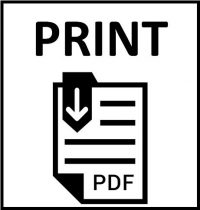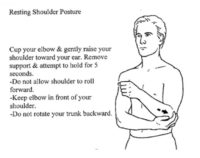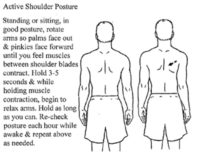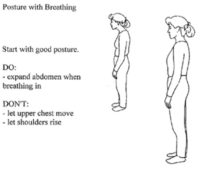by Andrew Coughlin MD, Robert Lindau MD, Sarah Cockle PT/DPT
What is it?
Shoulder dysfunction is a condition where the muscles is your neck and upper back are weakened. This can occur when the nerve that helps control some of the muscles of the shoulder is stretched, damaged or affected by tumor. Radiation therapy alone or in combination with surgery may also play a significant role in causing shoulder dysfunction. Shoulder dysfunction ultimately leads to an inability to completely raise your arm above your shoulder.
How common is it among head and neck cancer patients?
Patients undergoing neck dissection, or removal of lymph nodes from the neck, can have a very wide range of shoulder dysfunction after treatment. Reported numbers are highly variable for neck pain/stiffness, shoulder range of motion and neck range of motion. It is important to remember that every patient is different just as every tumor is different. Therefore, the key is to recognize you are having trouble and let someone know so that corrective treatment can be initiated.
What are the signs/symptoms?
Shoulder dysfunction can vary dramatically. Most patients with shoulder dysfunction notice decreased range of motion of the affected shoulder as well as pain or tightness when trying to raise the arm above the level of the shoulder. Patients with more severe dysfunction will also note decreased muscle mass on the affected side with asymmetry compared to the normal neck. The shoulder can be tilted down and the scapula can be jutting out. Symptoms may also vary depending on whether the dominant or non-dominant shoulder is affected.
How is it diagnosed?
Many surgeons may know after surgery the extent to which the accessory nerve was involved or affected with the procedure; however, many times it will not become apparent for days or weeks as to how significant the weakness may be. Therefore, most people will have an evaluation by physical therapist and occupational therapist as an inpatient prior to discharge from the hospital to assess postoperative shoulder function and determine how aggressive rehabilitation therapy needs to be.
How is it treated?
Shoulder dysfunction is treated with physical therapy and occupational therapy. These therapists will recommend specific exercises to strengthen the muscles and nerves involved. This requires significant patient adherence with recommended therapy and often several individual visits to the therapist to ensure proper performance of the exercises. Patient buy-in is paramount as performing these exercises at home, outside of therapy, is critical to increasing the chances of successful functional outcomes.
Initially treatment is focused on performing exercises in a pain free range of motion and gradually pushing the muscles to “do more” in order to regain full range of function. Unfortunately use of these muscles is required to maintain the benefits gained from therapy. If you stop doing the exercises, shoulder stiffness and decreased mobility can occur again. This may require starting back at square one. Your physical therapist will be instrumental in guiding you with the appropriate exercises and specifics to those exercises.
When should I call my doctor?
Many patients will have shoulder dysfunction that gets better with exercise and worse with inactivity. If you feel that your shoulder function has worsened to a point that you cannot perform the activities that you were once able to do, consider calling your physician’s office and ask for a new referral to physical therapy to re-establish care.
Below are Tips and Exercises for patients after Head and Neck Cancer Treatment
 POSITIONING: It is important for proper shoulder positioning after surgery. We recommend supporting the arm with a pillow or arm rest when sitting up and NOT allowing the arm to hang freely at your side. One suggestion is to place your hand in your pocket or support it on your purse strap while walking. The key is to not allow the full weight of the arm to pull on the shoulder. Please refer to the attached picture titled RESTING SHOULDER POSTURE.
POSITIONING: It is important for proper shoulder positioning after surgery. We recommend supporting the arm with a pillow or arm rest when sitting up and NOT allowing the arm to hang freely at your side. One suggestion is to place your hand in your pocket or support it on your purse strap while walking. The key is to not allow the full weight of the arm to pull on the shoulder. Please refer to the attached picture titled RESTING SHOULDER POSTURE.
 POSTURE: Maintaining good posture with your head and shoulders in alignment with your hips is important. Check your posture frequently throughout the day to avoid slouching to ensure your head is not bending forward or down. Also, be sure your shoulders are rolled back with your shoulder blades squeezed together. Refer to the attached picture titled ACTIVE SHOULDER POSTURE.
POSTURE: Maintaining good posture with your head and shoulders in alignment with your hips is important. Check your posture frequently throughout the day to avoid slouching to ensure your head is not bending forward or down. Also, be sure your shoulders are rolled back with your shoulder blades squeezed together. Refer to the attached picture titled ACTIVE SHOULDER POSTURE.
 BREATHING: Deep breathing exercises are important to perform to help prevent pneumonia and muscle tightness especially when you are experiencing pain. Breathe in through your nose and out through your mouth. Refer to the picture attached titled POSTURE WITH BREATHING.
BREATHING: Deep breathing exercises are important to perform to help prevent pneumonia and muscle tightness especially when you are experiencing pain. Breathe in through your nose and out through your mouth. Refer to the picture attached titled POSTURE WITH BREATHING.
Where can I learn more?
Gane EM, Michaleff ZA, Cottrell MA, McPhail SM, Hatton AL, Panizza BJ, O’Leary SP.
Prevalence, incidence, and risk factors for shoulder and neck dysfunction after neck dissection: A systematic review. Eur J Surg Oncol. 2017 Jul;43(7):1199-1218. doi: 10.1016/j.ejso.2016.10.026. Epub 2016 Nov 17.
Dijkstra PU, van Wilgen PC, Buijs RP, Brendeke W, de Goede CJ, Kerst A, Koolstra M, Marinus J, Schoppink EM, Stuiver MM, van de Velde CF, Roodenburg JL. Incidence of shoulder pain after neck dissection: a clinical explorative study for risk factors. Head Neck. 2001 Nov;23(11):947-53.
Leipzig B, Suen JY, English JL, Barnes J, Hooper M. Functional evaluation of the spinal accessory nerve after neck dissection. Am J Surg 1983; 146: 526–530.
Bradley PJ, Ferlito A, Silver CE, Takes RP, Woolgar JA, Strojan P, Suárez C, Coskun H, Zbären P, Rinaldo A. Neck treatment and shoulder morbidity: still a challenge. Head Neck. 2011 Jul;33(7):1060-7. doi: 10.1002/hed.21495. Epub 2010 Oct 19.